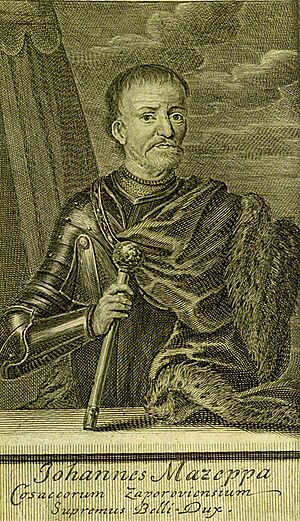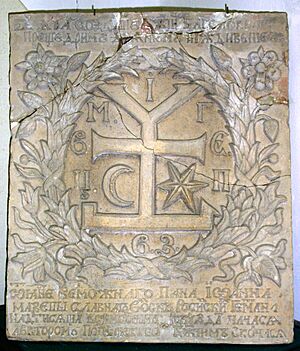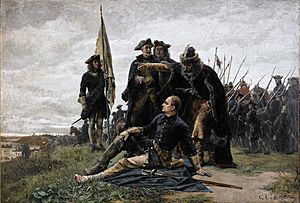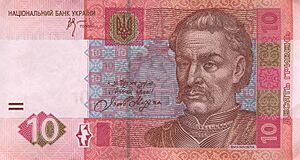Ivan Mazepa facts for kids
Quick facts for kids
Ivan Mazepa
|
|
|---|---|
|
Іван Мазепа
|
|
 |
|
| Hetman of the Zaporizhian Host | |
| In office 25 July 1687 – 11 November 1708 |
|
| Preceded by | Ivan Samoylovych |
| Succeeded by |
|
| Personal details | |
| Born | 30 March 1639 (NS) Bila Tserkva, Kiev Voivodeship, Crown of the Kingdom of Poland, Polish–Lithuanian Commonwealth |
| Died | 2 October 1709 (aged 70) (NS) Bender (Tighina), Principality of Moldavia |
| Nationality | Ukrainian |
| Spouse | Hanna Polovets (1642–1704) |
| Signature |  |
Ivan Mazepa (born March 30, 1639 – died October 2, 1709) was an important Ukrainian leader. He served as the Hetman of the Zaporizhian Host (a Cossack state) from 1687 to 1708. He was known for supporting artists and building beautiful churches.
Mazepa played a key role in the Great Northern War. He first supported Tsar Peter I of Russia. But when he learned the Tsar planned to replace him, he changed sides. Mazepa then joined King Charles XII of Sweden. This decision had a huge impact on how Russia and Ukraine saw their history.
The Russian Orthodox Church officially condemned Mazepa in 1708. They still haven't changed their minds about him. But other church leaders, like the Ecumenical Patriarchate of Constantinople, didn't agree. They thought it was a political move, not a religious one.
For a long time, people in Ukraine who wanted independence were sometimes called "Mazepists" in a negative way. During Soviet times, Mazepa was seen as a bad guy in Ukrainian history. But after Ukraine became independent in 1991, people started to see him as a hero. Today, a Ukrainian warship is named after him.
Contents
Early Life and Education

Ivan Mazepa was likely born on March 30, 1639. His birthplace was Mazepyntsi, near Bila Tserkva. This area was then part of the Polish–Lithuanian Commonwealth. Today, it is in Ukraine.
He came from a noble Ukrainian family. His mother was Maryna Mokievska, and his father was Stefan Adam Mazepa. His mother's family included a Cossack officer. His father was a Cossack leader in Bila Tserkva.
Education and Polish Service
Mazepa probably studied at the Kiev Academy from age 10. He learned about rhetoric there. He might have also studied philosophy in Warsaw.
From 1659, the Polish king sent him on many diplomatic trips to Ukraine. He also traveled across Western Europe. Mazepa's time serving the Polish king made some people call him a "Lyakh" (a Polish person). Later, the Russian government used this to try and make him look bad.
Mazepa stayed in the Polish king's service until about 1668.
Serving Cossack Leaders
After his father died around 1665, Mazepa inherited a noble title. From 1669 to 1673, he worked for Petro Doroshenko. Doroshenko was the Hetman of Right-Bank Ukraine. Mazepa was a squadron commander and went on diplomatic missions. He traveled to Poland, Crimea, and the Ottoman Empire.
In 1674, Mazepa was captured by a Cossack leader named Ivan Sirko. After this, he served Doroshenko's rival, Hetman Ivan Samoylovych. From 1677 to 1678, Mazepa took part in campaigns to help Yuri Khmelnytsky regain power.
Mazepa was well-educated and quickly rose through the Cossack ranks. From 1682 to 1686, he served as a high-ranking officer.
Becoming Hetman
In 1687, Ivan Mazepa accused Hetman Samoylovych of trying to break away from Russia. With support from Vasily Galitzine, Mazepa became the new Hetman. He was elected Hetman of Left-bank Ukraine in Kolomak. At this time, Mazepa signed the Kolomak Articles. These rules were based on earlier agreements.
During his time as Hetman, Mazepa became very rich. He owned a lot of land, making him one of the biggest landowners in Europe. He also supported the building of many churches across Ukraine. These churches were built in the beautiful Ukrainian Baroque style.
Mazepa also helped education in Ukraine. He founded schools and printing houses. He made the Kiev-Mohyla Academy bigger. This was the main school in Ukraine, and it grew to have 2,000 students.
In 1702, Cossacks in Right-bank Ukraine started a rebellion against Poland. Mazepa convinced Tsar Peter I to let him help. He successfully took control of large parts of Right-bank Ukraine. This happened while Poland was weak from an invasion by the Swedish king, Charles XII.
The Great Northern War
In the early 1700s, Russia was losing land in the Great Northern War. Tsar Peter I decided to make his army stronger and control his country more tightly. Mazepa worried that this would reduce the freedom of the Cossack Hetmanate. This freedom was promised in the Treaty of Pereyaslav in 1654.
The Tsar started asking Cossacks to fight in distant wars. They had to fight in places like Livonia and Lithuania. This meant their homes were left unprotected from enemies like the Tatars and Poles. The Cossacks were not well-equipped for these modern wars. They suffered many losses and felt discouraged. Mazepa also felt his position as Hetman was in danger.
Changing Sides
The final problem between Mazepa and Tsar Peter happened in 1708. The Polish King Stanisław Leszczyński, who was an ally of Charles XII of Sweden, threatened to attack Ukraine. Tsar Peter refused to send enough soldiers to defend Ukraine. He believed King Charles of Sweden would attack Russia directly and needed all his forces.
Mazepa felt this broke the Treaty of Pereyaslav. He believed Russia was not protecting Ukraine's land. So, on October 28, 1708, Mazepa allied with the Swedish and Polish armies. However, only about 3,000 Cossacks followed him. Most Cossacks stayed loyal to the Tsar.
When the Tsar learned of Mazepa's decision, the Russian army attacked. They destroyed Baturyn, the capital of the Cossack Hetmanate. Most of the soldiers defending it were killed, along with many ordinary people. The Russian army even tied dead Cossacks to crosses and floated them down the Dnieper River.
The Cossacks who did not join Mazepa elected a new hetman, Ivan Skoropadsky. Many Ukrainians were afraid of Russian revenge. They also didn't fully trust Mazepa's new Swedish allies. So, most people did not side with Mazepa.
The only major support Mazepa received was from the Zaporozhian Sich. Even though they had disagreed with Mazepa before, they saw him as a better choice than the Tsar. But Russia responded harshly. Tsar Peter ordered the Sich to be destroyed in 1709. He also ordered that any active Zaporizhian Cossack be executed.
The Final Battle
In the first half of 1709, the Swedish and Russian armies prepared for a big battle. They also tried to get support from the local people. Finally, in June, the Battle of Poltava took place. Russia and Peter the Great won this battle. This ended Mazepa's hopes of Ukraine becoming independent with Swedish help.
Mazepa fled with Charles XII to Bender (Tighina). This was a fortress in Moldavia, which was part of the Ottoman Empire. Mazepa died there soon after.
He was buried in Galați, which is now in Romania. But his tomb was moved several times. It was eventually lost when the church where he was buried was torn down in 1962.
Historical View of Mazepa
Mazepa's choice to leave the Russian Empire was seen as treason by the Russian Tsar. They believed it broke the Treaty of Pereyaslav. However, others argue that Russia broke the treaty first. They say Russia did not protect Ukraine's land while Cossacks were fighting in distant wars. Many Cossacks also died while building Saint Petersburg.
For a long time, Russian and Soviet history saw Mazepa as a traitor. The Russian Orthodox Church officially condemned him for political reasons. Until 1869, his name was even on a list of traitors cursed in Russian churches. During Soviet times, it was forbidden to have a positive view of Mazepa. This was seen as "Ukrainian nationalism."
But during the time of Perestroika (changes in the Soviet Union), new historical writings appeared. These writings showed Mazepa in a different light. After Ukraine became independent in 1991, Mazepa was seen as a national hero. He was the first Hetman after the Pereyaslav Treaty to stand up to the Tsar. This view is still debated by some pro-Russian groups. Russia has often criticized Ukraine for honoring Mazepa.
In 2009, a survey in Ukraine showed mixed views. 30 percent of people saw Mazepa as "a man who fought for the independence of Ukraine." But 28 percent saw him as "a turncoat who joined the enemy's ranks."
In 2009, Ukrainian President Viktor Yushchenko said that the idea of Mazepa being a traitor should be corrected. He said Mazepa wanted an independent Ukraine. He also noted that Ukrainian architecture thrived during Mazepa's rule. That same day, about 100 people protested in Simferopol against honoring Mazepa. In May 2009, Russia's foreign ministry said Ukraine's plans to honor Mazepa were an "artificial confrontation with Russia."
Mazepa's picture is on the ₴10 (Ukrainian currency) bill.
In August 2009, a monument to Mazepa was revealed in Chernihiv. The opening had some clashes between police and people who opposed Mazepa.
In 2009, President Yushchenko said his family might be connected to Mazepa's family. In 2016, a Mazepa monument was unveiled in Poltava by President Petro Poroshenko.
In July 2010, part of Ivan Mazepa Street in Kyiv was renamed. This caused some protests. In Galați, Romania, two neighborhoods and a statue are named after Mazepa.
Cultural Legacy

Mazepa's life has inspired many books, poems, and musical works:
- Lord Byron wrote the poem Mazeppa (1818).
- Alexander Pushkin wrote the poem Poltava (1828–1829).
- Victor Hugo wrote the poem Mazeppa (1829).
- Juliusz Słowacki wrote the drama Mazeppa (1840).
- Franz Liszt composed the symphonic poem Mazeppa (1851).
- Pyotr Ilyich Tchaikovsky composed the opera Mazeppa (1881–1883).
- A Ukrainian film called Молитва за гетьмана Мазепу was released in 2002.
In 2009, the President of Ukraine created the Cross of Ivan Mazepa. This award is given for cultural achievements and service.
In 2020, President Volodymyr Zelenskyy gave the 54th Mechanized Brigade of the Ukrainian Army the honorary title "Ivan Mazepa." In 2022, Zelenskyy named a Ukrainian warship after Mazepa.
See also
 In Spanish: Iván Mazepa para niños
In Spanish: Iván Mazepa para niños
- Ivan Mazepa's Hetman's Banner
- List of Ukrainian rulers
- Mazepa family





